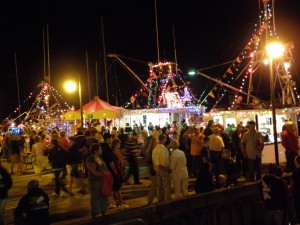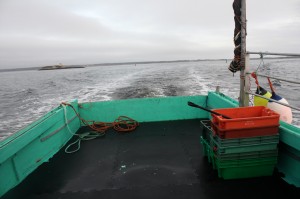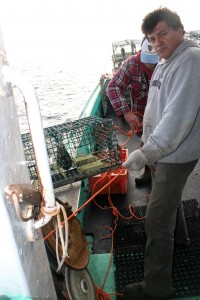 Five years before the first permanent European settlers arrived in Lockeport, a lone man named Josiah Churchill set out from Liverpool in his small boat with little aboard but some fishing equipment and his pet pig. When he reached the island that is now Lockeport, he found a Mi’kmaq tribe called the Sibinisks, set up camp and proceeded to catch and salt fish. Of course, because he arrived so late, he was stuck there for the winter. Fish and the generosity of his neighbours kept him alive. The next spring, Churchill returned to Liverpool and suggested to his friends, the Locke brothers, that they check out the excellent harbour down the coast. The Lockes took Josiah’s advice, built a church and some homes and started fishing. Lockeport was born.
Five years before the first permanent European settlers arrived in Lockeport, a lone man named Josiah Churchill set out from Liverpool in his small boat with little aboard but some fishing equipment and his pet pig. When he reached the island that is now Lockeport, he found a Mi’kmaq tribe called the Sibinisks, set up camp and proceeded to catch and salt fish. Of course, because he arrived so late, he was stuck there for the winter. Fish and the generosity of his neighbours kept him alive. The next spring, Churchill returned to Liverpool and suggested to his friends, the Locke brothers, that they check out the excellent harbour down the coast. The Lockes took Josiah’s advice, built a church and some homes and started fishing. Lockeport was born.
This story says so much about how the people, the culture and the towns of what we call Sou’West Nova Scotia came to be. It was fish, not Josiah’s pig that kept him alive. The pig wasn’t touched, except by the Mi’kmaq who repeatedly kidnapped it in an apparent attempt to figure out what it was. We tend to be a stubbornly independent bunch with a fierce pride in our relationship to the sea and to the fishery and the ability of both to sustain us. It’s literally true that the fishery built this coast. We settled in the best harbours closest to the best inshore and offshore fishing grounds.
 Along with trade, shipbuilding and lumber, fishing contributed to the look of our towns and villages. Lighthouses, breakwaters, wharves, slips and stores became what are now our historic water “fronts” with the rest of the settlement built behind and along the coast by the inshore fishermen, the deckhands and later the plant workers. When fish processing took off as an industry, fish plants came to dominate our waterfronts. Even as shipbuilding and trade died out, our waterfronts grew into a labyrinth of wharves built specifically to support the ever-growing fishing fleets until today when the famous Cape Islander in its modern form lies four aside at wharves from Digby to Lockeport and beyond.
Along with trade, shipbuilding and lumber, fishing contributed to the look of our towns and villages. Lighthouses, breakwaters, wharves, slips and stores became what are now our historic water “fronts” with the rest of the settlement built behind and along the coast by the inshore fishermen, the deckhands and later the plant workers. When fish processing took off as an industry, fish plants came to dominate our waterfronts. Even as shipbuilding and trade died out, our waterfronts grew into a labyrinth of wharves built specifically to support the ever-growing fishing fleets until today when the famous Cape Islander in its modern form lies four aside at wharves from Digby to Lockeport and beyond.
Even the way the English language evolved here reflects a fishing influence. If you doubt the truth of a claim someone is making, you might say, “I’ll tow that one alongside for a bit before I bring it aboard.” We all know a tinker is an undersized lobster, but we’ve come to apply the word to nearly anything small. “Fish or cut bait,” an expression of uncertain North American origin, is now used around the world to urge someone to make a decision.
 Today, it’s easy to show how important the fishery is to the culture and economy of Sou’West Nova Scotia. In 2007, the 11,724 fishermen in the Scotia Fundy region of Nova Scotia (northern Cape Breton to the New Brunswick border) fishing out of 4644 boats with 10,744 licenses landed a grand total of 232,848 metric tonnes of fish worth $529,950,000. Except perhaps for government services like schools and hospitals, no other kind of work comes close to supporting the people of these shores. But the fishing life is also easy to romanticize. In contrast to the image of the stoic, slightly comic fisherman conjured by the Bluenose and sou’westers, real fishing is hard, dangerous work. I grew up in a fishing family, lived the poverty and watched the emotional and physical toll it took on my grandfathers, my father, my uncles and my aunts. Towns along this coast have built monuments to their lost fishermen, Lockeport’s to the 17 men killed in a 1961 storm, for example. For centuries fishing was a bare subsistence living for the average fisherman. And now over the past few decades, fishermen and their families are prospering at last.
Today, it’s easy to show how important the fishery is to the culture and economy of Sou’West Nova Scotia. In 2007, the 11,724 fishermen in the Scotia Fundy region of Nova Scotia (northern Cape Breton to the New Brunswick border) fishing out of 4644 boats with 10,744 licenses landed a grand total of 232,848 metric tonnes of fish worth $529,950,000. Except perhaps for government services like schools and hospitals, no other kind of work comes close to supporting the people of these shores. But the fishing life is also easy to romanticize. In contrast to the image of the stoic, slightly comic fisherman conjured by the Bluenose and sou’westers, real fishing is hard, dangerous work. I grew up in a fishing family, lived the poverty and watched the emotional and physical toll it took on my grandfathers, my father, my uncles and my aunts. Towns along this coast have built monuments to their lost fishermen, Lockeport’s to the 17 men killed in a 1961 storm, for example. For centuries fishing was a bare subsistence living for the average fisherman. And now over the past few decades, fishermen and their families are prospering at last.
 Because fishing has created our coastline, shaped our words, buttered our bread and stolen far too many of our fathers and sons, we’ve created events to show our gratitude and our respect for this way of life. On Founder’s Days in Shelburne and during Seafest in Yarmouth, fishermen deck out their boats in lights and steam along the shore. Shelburne County holds an annual lobster festival at the end of the season in spring. Lockeport hosts an annual sea derby during which people of all ages catch everything from mackerel to shark. Digby’s Scallop Days and Wedgeport’s Tuna Festival pay tribute to their respective fisheries. Once known as the tuna sport fishing capital of the world, Wedgeport held its first international tuna fishing tournament in 1937 attracting many celebrities over the years including Babe Ruth, Amelia, Earhart, Zane Grey, Jean Belliveau and Franklin Roosevelt.
Because fishing has created our coastline, shaped our words, buttered our bread and stolen far too many of our fathers and sons, we’ve created events to show our gratitude and our respect for this way of life. On Founder’s Days in Shelburne and during Seafest in Yarmouth, fishermen deck out their boats in lights and steam along the shore. Shelburne County holds an annual lobster festival at the end of the season in spring. Lockeport hosts an annual sea derby during which people of all ages catch everything from mackerel to shark. Digby’s Scallop Days and Wedgeport’s Tuna Festival pay tribute to their respective fisheries. Once known as the tuna sport fishing capital of the world, Wedgeport held its first international tuna fishing tournament in 1937 attracting many celebrities over the years including Babe Ruth, Amelia, Earhart, Zane Grey, Jean Belliveau and Franklin Roosevelt.
John Soles, Digby Scallop Days Chair, says of the 35-year-old festival, “It’s a sign of our heritage because that’s what Digby is built on. It’s known around the world for scallops.” Economically, scallops and fishing are vital to Digby’s prosperity. “Our fleet is very large,” says Soles. “Fishing is at least 75% of money coming into the town. They’re all local men. They spend their money in town.” Soles believes fishing has created a secondary industry. “Tourism is really taking off because of the wharves, the harbour, the boats. I work on the wharf down here and people from out west, they’ve never seen anything like this.”
Larry Peach, Tourism Development Manager with YASTA (Yarmouth and Acadian Shores Tourism Association), says, “Visitors are just curious. They want to know what’s being fished. They’re interested in the boats. This is an opportunity to talk to somebody who does this for a living.”
There’s no question that the fishery and tourism will continue to evolve together and for one good reason – authenticity. The people of this region don’t celebrate the fishery to attract tourists. We do so because the fishery is so deeply a part of who we are. That kind of authenticity is what tourists the world over are seeking. I feel privileged to be a part of it every day of my life because fishing made me too.
Photo Credits
All photos by Darcy Rhyno
“Yarmouth Parade of Lights with fishing boats decorated”
“Fishing boats on the slip for the summer at Little Harbour near Lockeport”
“Coming home on “dumping day” after setting the season’s lobster traps”
“Tim Rhyno setting lobster traps off Lockeport, Nova Scotia”


Glad you liked it, June. I’ve had a lot of positive comments on the article and I think you’ve hit the nail on the head. It’s because people feel how deeply shaped they are by fishing, right down to the way they talk, but don’t often think much about it.
Hi Darcy
This is a wonderful article. Good work. Any of us that have grown up in this area are aware, or should be of the deeply rooted heritage from our fishing industry and the families affected by it. This article brings it all together. Thanks
June